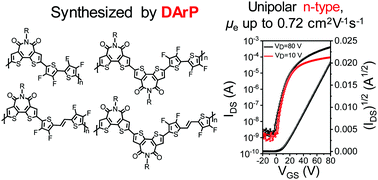n-Type conjugated polymers comprising bithiophene imide and multifluorinated thiophene moieties synthesized by direct arylation polycondensation†
Abstract
We synthesized four n-type conjugated polymers comprising a bithiophene imide (BTI) unit and 3,3′,4,4′-tetrafluoro-2,2′-bithiophene (4FBT) or (E)-1,2-bis(3,4-difluorothien-2-yl)ethene (4FTVT) via direct arylation polycondensation, and comprehensively studied the optical, electrochemical and charge transport properties of the polymers. Increasing the BTI acceptor unit from one to two in the repeating unit slightly decreased the frontier molecular orbital levels of the polymers and blue-shifted their absorption spectra. Moreover, this change altered the molecular packing from an edge-on backbone orientation to bimodal packing with mixed edge-on and face-on orientations. When used as semiconductor layers in organic thin-film transistors, all four polymers exhibited unipolar n-type transport behavior with the highest saturation and a linear electron mobility of 0.72 and 0.67 cm2 V−1 s−1, respectively. Our findings suggest that direct arylation polycondensation can serve as an ecofriendly protocol for the synthesis of high-performance n-type conjugated polymers based on BTI through careful molecular design.

- This article is part of the themed collection: Journal of Materials Chemistry C Emerging Investigators


 Please wait while we load your content...
Please wait while we load your content...